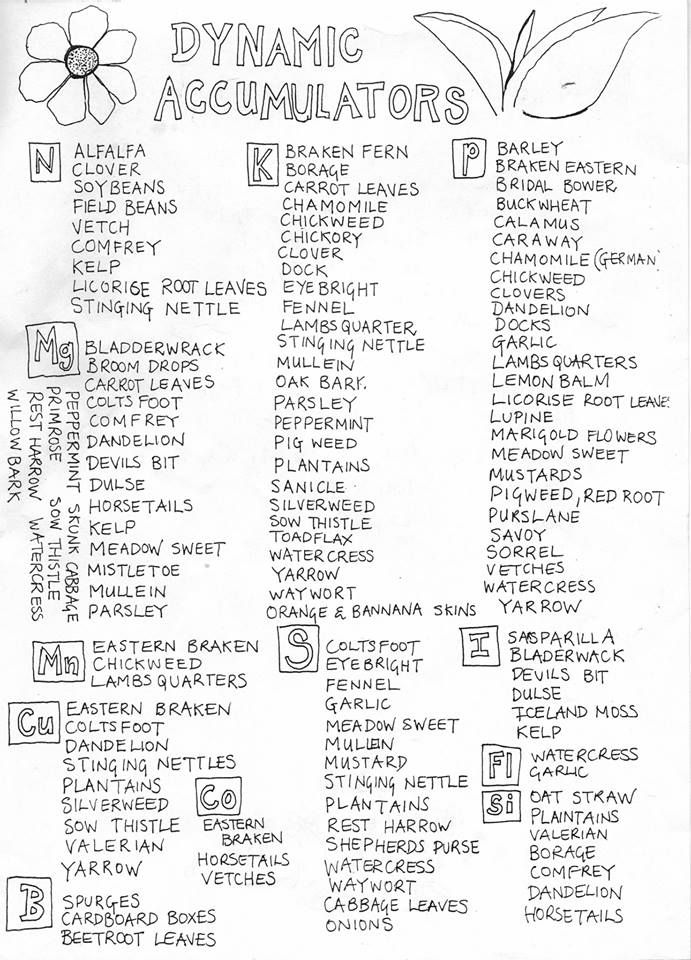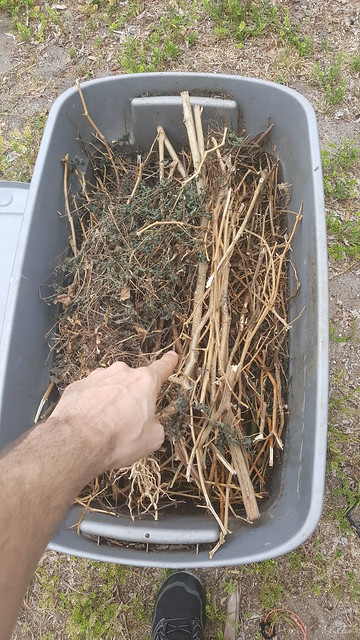In a few different threads the topic of mulching to provide a soil with everything it requires was brought up.
When I first joined this forum there were a lot of posts discussing how to provide nutrition to a plant. There was a lot of conflicting information on the best growing media, nutrient ratios, nutrient lockout, nutrient burn, fixing yellowing of leaves etc etc.
I started learning and practicing organic gardening because I didn't want to care about my NPK ratio or whether or not I needed molybdenum or not. I didn't want to measure the pH of my runoff or worry about the ppm of my water. I'm not saying that this is the best way but I really enjoy how simple it is and how all I need to do is mulch and water with plain water. It's "good enough" for this hobby grower. I also care about the environment and stay away from commercially processed products as much as possible
What are dynamic accumulators?
Dynamic accumulators are plants that gather certain micronutrients, macronutrients, or minerals and store them in their leaves. These plants can be used either for detoxifying soil or for gathering a certain nutrient or mineral from an area. For instance, clovers will mine great quantities of nitrogen out of the air via a symbiotic relationship with bacteria. These bacteria convert gaseous nitrogen into a form available to the clover, and exchange this nitrogen for exudates/sugars given by the clover. When the clover dies or is cut down, the green matter breaks down and releases the nitrogen into the soil.
These plants become rich in a certain substance and can then be cut down. This can be used as a fertilizer or as part of a fertilizer mix for other plants that may be deficient in those particular nutrients. The use of a nitrogen dynamic accumulator, such as a clover patch, could potentially replace nitrogen-rich fertilizers. These types of plants play an important role in many permaculture guilds.
Microbiologist Kristine Nichols of the University of Maryland showed that grasses like switchgrass, blue grama, Indian grass not only send down deep roots but increase glomalin levels and arbuscular mycorrhizal fungi. These fungi help "glue" the soil together, make it coherent, and shuttle biologically available nutrients from soil to plant. Some land reclamation companies are now using arbuscular mycorrhizal fungi and triticale to accomplish a similar end, and most likely Orchard grass (especially in combination with chicory and clover), and yacon, Jerusalem artichoke, chicory and many other plants will also eventually be shown to increase glomalin. Whatever that mysterious quality of "fertile" and "fertility" turns out to be in the soil, it must have something to do with these processes.
The plants with function as dynamic accumulators are often traditionally regarded as companion plants. In those cases, a plant such as yarrow or alfalfa growing near other plants, or in some cases being used as a green manure or cover crop, will show benefits to other plants due in part to the nutrients selected and exchanged. Among the accumulator plants of broadest nutrient variety are dandelion, plantains, watercress, comfrey, and kelp. Under good soil and growing conditions, certain plants may extract higher levels of nutrients than others, with consistency, although removing those nutrients from that soil can create a void in availability. Therefore, composts made with accumulator plants should also be reintroduced to those same growing areas upon compost completion. [Wikipedia]
So it's fairly simple - You grow the plant either as a companion plant or you grow it in the ground and either compost the vegetation or use it as a mulch for your plants.
Comfrey is apparently the bees knees- it's roots go incredibly deep and it will mine nutrients from areas unavailable to other plants.
Growing a dynamic accumulator plant in a pot is probably pointless, unless if you're using it as a nitrogen fixing companion plant
Below is a picture listing many dynamic accumulators and what they accumulate. I fact checked a lot of these as it not cited and just someone's drawing but everything I researched showed it to be correct

When I first joined this forum there were a lot of posts discussing how to provide nutrition to a plant. There was a lot of conflicting information on the best growing media, nutrient ratios, nutrient lockout, nutrient burn, fixing yellowing of leaves etc etc.
I started learning and practicing organic gardening because I didn't want to care about my NPK ratio or whether or not I needed molybdenum or not. I didn't want to measure the pH of my runoff or worry about the ppm of my water. I'm not saying that this is the best way but I really enjoy how simple it is and how all I need to do is mulch and water with plain water. It's "good enough" for this hobby grower. I also care about the environment and stay away from commercially processed products as much as possible
What are dynamic accumulators?
Dynamic accumulators are plants that gather certain micronutrients, macronutrients, or minerals and store them in their leaves. These plants can be used either for detoxifying soil or for gathering a certain nutrient or mineral from an area. For instance, clovers will mine great quantities of nitrogen out of the air via a symbiotic relationship with bacteria. These bacteria convert gaseous nitrogen into a form available to the clover, and exchange this nitrogen for exudates/sugars given by the clover. When the clover dies or is cut down, the green matter breaks down and releases the nitrogen into the soil.
These plants become rich in a certain substance and can then be cut down. This can be used as a fertilizer or as part of a fertilizer mix for other plants that may be deficient in those particular nutrients. The use of a nitrogen dynamic accumulator, such as a clover patch, could potentially replace nitrogen-rich fertilizers. These types of plants play an important role in many permaculture guilds.
Microbiologist Kristine Nichols of the University of Maryland showed that grasses like switchgrass, blue grama, Indian grass not only send down deep roots but increase glomalin levels and arbuscular mycorrhizal fungi. These fungi help "glue" the soil together, make it coherent, and shuttle biologically available nutrients from soil to plant. Some land reclamation companies are now using arbuscular mycorrhizal fungi and triticale to accomplish a similar end, and most likely Orchard grass (especially in combination with chicory and clover), and yacon, Jerusalem artichoke, chicory and many other plants will also eventually be shown to increase glomalin. Whatever that mysterious quality of "fertile" and "fertility" turns out to be in the soil, it must have something to do with these processes.
The plants with function as dynamic accumulators are often traditionally regarded as companion plants. In those cases, a plant such as yarrow or alfalfa growing near other plants, or in some cases being used as a green manure or cover crop, will show benefits to other plants due in part to the nutrients selected and exchanged. Among the accumulator plants of broadest nutrient variety are dandelion, plantains, watercress, comfrey, and kelp. Under good soil and growing conditions, certain plants may extract higher levels of nutrients than others, with consistency, although removing those nutrients from that soil can create a void in availability. Therefore, composts made with accumulator plants should also be reintroduced to those same growing areas upon compost completion. [Wikipedia]
So it's fairly simple - You grow the plant either as a companion plant or you grow it in the ground and either compost the vegetation or use it as a mulch for your plants.
Comfrey is apparently the bees knees- it's roots go incredibly deep and it will mine nutrients from areas unavailable to other plants.
Growing a dynamic accumulator plant in a pot is probably pointless, unless if you're using it as a nitrogen fixing companion plant
Below is a picture listing many dynamic accumulators and what they accumulate. I fact checked a lot of these as it not cited and just someone's drawing but everything I researched showed it to be correct



